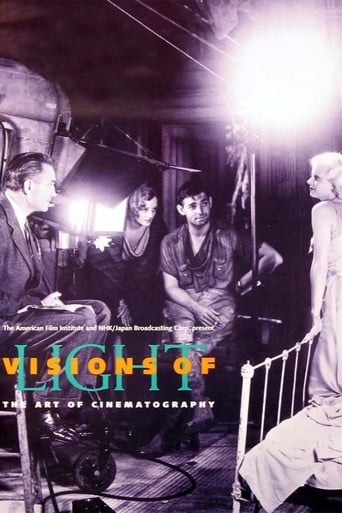

The greatest movie ever!
... View MoreDon't listen to the negative reviews
... View MoreCrappy film
... View MoreThere is just so much movie here. For some it may be too much. But in the same secretly sarcastic way most telemarketers say the phrase, the title of this one is particularly apt.
... View More... how can you make such documentary, interview sven nyquist, yet show no frame of his work? i am sure that many people find many people missing, yet sven is really admired as one of the very best ever and i have immediately tons of frames of his work in mind, more than from any other DOP ...nevertheless it is a great piece and does not become unnecessary detailed in technical issues. i am not entirely sure about the selection of material they presented. but this is necessarily highly subjective. yet i would have wished to see more of Japanese and European cinema. the more i think about it the more i feel that i find it great that they produced this tribute to cinematographers, but i am more and more unhappy by the way they did it. leaves with the taste of a too clean feature film. too little risk. so i change my vote from initially 9 to 6.
... View MoreI was a film student in college, but my primary interest was in the story/writing end. While I wasn't totally into the directing and cinematography aspects, I did have a lot of exposure to it, being that the University of Utah film program forces you to have a well-rounded background in all the basics of film-making.I was also a teacher's assistant in college to a great film professor, who made it a habit of showing this documentary to his classes to introduce them to the field they were getting into. After the three times I was "forced" to watch this piece, I can truly say I gained a treasured respect and appreciation for the mechanics of film. Yes it's story..yes it's acting...but really, the story is conveyed through images--and best conveyed through images captured by those who know what they're doing. There is so much thought that goes into being a good DP--being aware of your surroundings, lighting, being innovative enough to solve problems (because they come up a lot), and how to make an actor look good or how to get the best shot of something. Rather than explaining like a text book "how to be a good DP," the film is composed of a series of documentary type interviews and clips from influential films over the years--films like "Sunrise" from the silent era, to modern films like "Days of Heaven," "Raging Bull," and "The Godfather." They give a good summary of the best examples of DP work, as well as highlighting why a particular cinematographer was viewed as a master in his field.This is a well put -together piece, and I'd definitely recommend it.
... View MoreI watched this to hopefully get some ideas on what movies would be interesting to watch. From this point of view I was disappointed.The movies used as illustration are fairly mainstream. I had heard of almost all of them even though I hadn't seen them all.One thing that I very much have a problem with is that I think that the frame speed was accelerated on some of the silent film clips. The alternative would have been to repeat some frames so that events would play at the intended speed, but would have a slight skipping irregular pace. (24 frames per second was not a standard film speed during the silent period, so many films were done in 16, 18 or even occasionally 12 frames per second) I believe that the latter solution to the frames problem is preferable to comically fast pacing.Also the silent period was some what gypped in that it got the same amount of time and focus as each subsequent decade. It should have gotten twice as much time as a decade, because it includes 1910's and 1920's and all prior movie history. Other than this minor disparity, the amount of time spent on each decade is about equal. This is good because the documentary isn't skewed toward any era.Even bias is a prerequisite for a film documentary, and this documentary has it.Keep in mind that this documentary is very general. It would be impossible to go into a great deal of depth in only 1 1/2 hours. It is not for an extreme film buff. The film is not going to be a revelation, but if you are looking for a very general introduction to cinema this is a good documentary to watch.
... View MoreThis is a great, I repeat great, documentary on the history of cinematography. No film student should be without it!! It covers all the changes in technology and techniques and its impact on film.It brilliantly shows the freedom of camera movement during the silent period and how things became more restricted when sound was added later and the transition from B/W to Color. But most importantly, clearly depicts how Directors of Photography over came these limitations and created new techniques which changed film history forever. Brilliant!!!! You'll never look at a film the same way after seeing this.Covers many different aspects of "the Hollywood look" and the different "Studio looks" throughout time. Also uncovers the secrets of many DP's and how they made their "Stars" look so incredible!!I especially like the section on Film Noir and the plethora of absolutely breath taking film clips!!! Included in this gem of a documentary are great clips from classics like the 1947 version of "Oliver Twist" and examples from some of the greatest DP's of all time!!! Arthur Miller...etc...Very entertaining!! Even for non-film buffs!!! I've showed this documentary to friends and relatives and they all seem to watch with amazement!!!I liked it so much I just had to buy it!
... View More